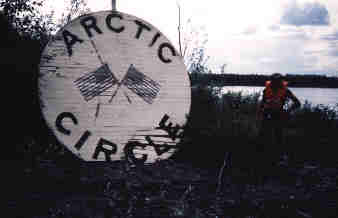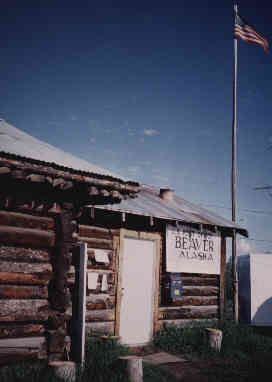DOWN THE YUKON-Page 6

About the only presence of human existence in the Flats is Fort Yukon, a small village of about 500 people and the largest city on the Alaskan portion of the Yukon river. This is also the only portion of the river which briefly crosses above the arctic circle so I set up my tripod and snapped a picture of me beside this obvious tourist sign that someone set up just for folks like me!

From my journal (June 16th;Day-28)..."Somewhere today I crossed the imaginary line called the arctic circle. No, I wasn't notified by an electrical shock, nor did the lush green vegetation bear any drastic changes from one side of the line to the other. The map just simply said that I'd crossed a dotted line with the words "arctic circle on it, so I guess that I can say that I've been there now."


This is the village of Beaver and it is very typical of all the small settlements that I would find on the rivers edge on to the Bering Sea. They consist mostly of Indians and fishing is the dominant industry by far. Their only link to the "outside" world is provided by the short bush airplane strips, although there is usually a short network of gravel roads in the direct vicinity of each village. I never saw a barge while I was on the Yukon, but the locals assured me that that is how their cars and trucks got there.
 This was the official United States Post Office for Beaver, Alaska... a small log room attached to the rear of the only store that I could find in town. In most of the fishing villages the post office was located inside the town store where I could mail my letters, then stock up on expensive fresh fruit, eggs, chocolate, and whatever else that my eyes desired! |
The Alaska oil pipeline

The Alaska pipeline is the longest above ground pipeline in the world and considered an engineering feat. It stretches the north/south length of Alaska from Prudhoe Bay to Valdez, carrying crude oil from the North Slope. It is above ground because the ground just one foot deep stays permanently frozen. There are heating stations about every 15 miles to keep the oil flowing.

From my journal (June 19th;Day-31)..."Around the next bend there was the trans-Alaska oil pipeline; faint sketches of silver pipe scattered on the hill like the mangled fragments of an exploded Boeing 747.
"At the base of the combined bridge/pipeline over the river I stopped to get out for a closer look. At the top of the bank was a pumping and heating station which was surrounded by barbed wire and FBI warning signs. Across the road was a huge base station like something out of the future and then almost as suddenly as I had arrived a helicopter lifted off from near the base station and headed straight toward me, then circled overhead!
"I then felt like I was living in a page of George Orwell's "1984" classic when suddenly I heard a loud speaker voice saying, "Would the person at the base of the bridge please leave immediately!". I then saw the moving arm of a camera following me from above so I then waved in a cooperative mannner and headed straight for my kayak, then I heard a "Thank you" from the speaker as I drifted away. Just as quickly as I had entered this noisy and confusing zone, I had also left it far behind into the vast wilderness that this truely was."


After around 1,200 miles I came to the town of Tanana and pulled my kayak up to where I saw the biggest building on shore; The Alaska Commercial Company as seen in the above photo. I enjoyed studying all the fine merchandise in the store then striking up a lively conversation with the owner. He even bragged about his prices being the lowest in town with eggs at $2.29/dozen. A pear, an apple, or an orange were priced at $1.00/each... your choice. Like all the villages on the Yukon, most everything comes in by airplane and the prices reflect such. In this desolate wilderness fresh fruit was a bargain at any price to me!
 Many of the Indians made their living from fishing for salmon migrating back upstream. This is one of the fishwheels along the rivers side which was propelled by the current and scooped up huge fish, then dumped them in a basket attached to the side of this "ferris-wheel" type devise. It was truely amazing to watch! |

On this part of the Yukon the salmon season was in full steam. Everywhere could be seen racks of the precious red meat drying in the sun. On several occasions I bought zip-lock bags of the meat and it was one of the most delecatable treats of my voyage!
 This is the post office in Ruby, Alaska. I especially liked the bird hotel on the roof! |

I didn't have many clothes so I had to wash them as often as possible, taking advantage of the sunny days for drying them on the deck of my kayak as I paddled down river!
 This is one of the last photos that I took on my trip down the Yukon, just before Marshall, Alaska where I decided to end my trip, only about 30 miles from the Bering Sea. Here the river had become more of an "Ocean" than a river, with very constant headwinds from the sea and a very wide expanse of water. It had become a struggle just to make a miles distance so I hired a pilot to fly me out of the bush thus ending one of the most memorable summers of my life. I will definitely be back again some day! |
THE END
back to YUKON DIRECTORY
